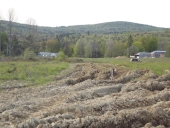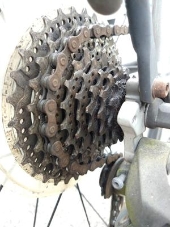
 2
2




Building soil in the Yukon.




"We're all just walking each other home." -Ram Dass
"Be a lamp, or a lifeboat, or a ladder."-Rumi
"It's all one song!" -Neil Young




 There are new bikes on the market for the $200 price range I know, but there are over 300 moving, engineered and manufactured parts on a bike. The only way I know to build that kind of machine for so cheap is to use slave labour (most cheap bikes are mass produced in China) or to build in the most environmentally filthy manner possible (again, most cheap bike are made in...). Don't be fooled by the hype: bike manufacturing is NOT a green industry. It's dirty. I have toured bike factories in Asia... it completely blew me away.
There are new bikes on the market for the $200 price range I know, but there are over 300 moving, engineered and manufactured parts on a bike. The only way I know to build that kind of machine for so cheap is to use slave labour (most cheap bikes are mass produced in China) or to build in the most environmentally filthy manner possible (again, most cheap bike are made in...). Don't be fooled by the hype: bike manufacturing is NOT a green industry. It's dirty. I have toured bike factories in Asia... it completely blew me away.
Building soil in the Yukon.




"We're all just walking each other home." -Ram Dass
"Be a lamp, or a lifeboat, or a ladder."-Rumi
"It's all one song!" -Neil Young








Judith Browning wrote:We've been wanting bikes again...is there anything you would recommend for mostly gravel/dirt roads with some pretty steep hills for under $200? Thanks.
![Filename: africabike_three.jpg
Description: This is the one I would like to have! she is gorgeous [Thumbnail for africabike_three.jpg]](/t/19042/a/7158/africabike_three.jpg)
 1
1




Chris Sturgeon wrote:Well, do ya? I'm a bike mechanic so I figured, why not ask?
Anything from repairs to storage to efficiency, I will do my best to respond.
![Filename: IMAG0488.jpg
Description: the twist shifter [Thumbnail for IMAG0488.jpg]](/t/19042/a/7159/IMAG0488.jpg)
![Filename: IMAG0486.jpg
Description: cable housing at the hub [Thumbnail for IMAG0486.jpg]](/t/19042/a/7160/IMAG0486.jpg)
![Filename: IMAG0485.jpg
Description: her bike [Thumbnail for IMAG0485.jpg]](/t/19042/a/7161/IMAG0485.jpg)




Q: Would it be possible to get a list of the more likely "quality" bike makers out there?
what one should expect to get as the price goes up.

 Unfortunately, as with many things, cheapest is not always the best value.
Unfortunately, as with many things, cheapest is not always the best value.
Building soil in the Yukon.








Sounds a little like going from a Chevy to and Olds to a Caddy
Building soil in the Yukon.




'Science is the father of knowledge, but opinion breeds ignorance.' - Hippocrates




find religion! church
kiva! hyvä! iloinen! pikkumaatila
get stung! beehives
be hospitable! host-a-hive
be antisocial! facespace




Building soil in the Yukon.









Chris Sturgeon wrote:Tel, What you have there is a classic case of molecular bonding. The real cure is prevention (sorry to be didactic). When you get that rusted bad-boy out and put in your new stem, be sure to coat the threads, quill, and anything else that touched with a molybdenum (white) grease. If there is any titanium on steel, steel on aluminum, or Ti on Al; be sure to use a copper buffer grease. At this point your best bet is a bath of penetrating oil (I like Tri-Flow, make sure you give it lots of time to capillary in... like a couple days) and mechanical force... but it sounds like you've tried that. A weighty iron bar used as an oversized punch and a 3 pound hammer. You can also try heating the lower steer tube a bit to ease the passage, but watch out so you don't scorch your paint! Of course make sure that the frame is clamped and secured in such a way as you don't tress the welds or impact the tubes as you do this gut-wrenching wrenching.
find religion! church
kiva! hyvä! iloinen! pikkumaatila
get stung! beehives
be hospitable! host-a-hive
be antisocial! facespace




Our inability to change everything should not stop us from changing what we can.





Robert Ray wrote: Just a quick idea for penetrating oil to loosen stuff up. Even stuff that has been near salt water is a 50/50 mix of regular ATF and acetone. It's a cheap mix that works extremely well. I learned it from an old boat mechanic.
find religion! church
kiva! hyvä! iloinen! pikkumaatila
get stung! beehives
be hospitable! host-a-hive
be antisocial! facespace





Building soil in the Yukon.




Building soil in the Yukon.





Chris Sturgeon wrote:How do you other riders react in hit or near-hit incidents?
find religion! church
kiva! hyvä! iloinen! pikkumaatila
get stung! beehives
be hospitable! host-a-hive
be antisocial! facespace








Building soil in the Yukon.




Building soil in the Yukon.




For unlimited return on all your investments - Make your deposits at 'The Entangled Bank' !




 ).
).
Building soil in the Yukon.





For unlimited return on all your investments - Make your deposits at 'The Entangled Bank' !




Building soil in the Yukon.




Chris Sturgeon wrote:Sorry for the two part post. I do most of my Permies surfing from work so my available time is limited.
I found a fairly clear page outlining things like chain tension, limiting screws and barrel adjustments. Check it out.
Let me know if you come across any issues. Once you get the limits set, you can pretty much tune by ear while riding... just tighten or loosen your shifter's barrel adjusters as you ride and listen for the sweet spot where your shifting makes the least amount of clatter.

|
Oh the stink of it! Smell my tiny ad!
The new permaculture playing cards kickstarter is now live!
https://www.kickstarter.com/projects/paulwheaton/garden-cards
|





